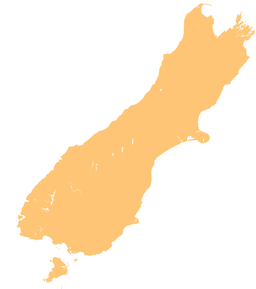Lake Rotorua is 8 kilometres (5.0 mi) due west of Kaikōura in the Canterbury region of the South Island of New Zealand.[1]
| Lake Rotorua, Canterbury | |
|---|---|
 2022 aerial view | |
| Coordinates | 42°24′29″S 173°34′53″E / 42.4081°S 173.581389°E |
| Basin countries | New Zealand |
| Surface area | 43 ha (110 acres) |
| Max. depth | 3 m (9.8 ft) |
| Surface elevation | 25 m (82 ft) |
| Settlements | Kaikōura |
A 2010 report showed that Lake Rotorua had the second highest trophic level index, an indication of pollutant levels, of all the lakes that were measured.[2] Topdressing, shags and willow trees contributed to the high levels of pollution. 29 species of green algae were identified.[3] The lake was fenced to keep cattle away from it and there were conflicting reports on pollution levels in 2022.[4][5] A wildlife reserve surrounds the lake, with birds including riroriro, toutouwai, pīpipi, pīwakawaka, korimako, tītitipounamu, kāruhiruhi, kuruwhengi, tētē, pūtangitangi, pūteketeke, mallard and Canada geese.[6]
The lake was formed by greywacke shingle in the Kahutara River building up to block the mouth of a former tributary.[3]
See also
editReferences
edit- ^ Bradley, Barry (1999). The Penguin New Zealand Atlas. Penguin (NZ). ISBN 0-14-028914-3.
- ^ Verburg, P.; Hamill, K.; Unwin, M.; Abell, J. (August 2010). Lake water quality in New Zealand 2010: Status and trends (PDF). Hamilton: National Institute of Water & Atmospheric Research Ltd.
- ^ a b V.M. Stout (1985). "The ecology of three small lakes near Kaikoura". Department of Zoology, University of Canterbury.
- ^ "Farmer sets tuna hinaki in lake after getting rid of algae". RNZ. 28 October 2022. Retrieved 10 March 2024.
- ^ "Lake Rotorua Water Quality". Land, Air, Water Aotearoa (LAWA). 2022. Retrieved 10 March 2024.
- ^ "Waterways in Kaikōura". Environment Canterbury. Retrieved 10 March 2024.
